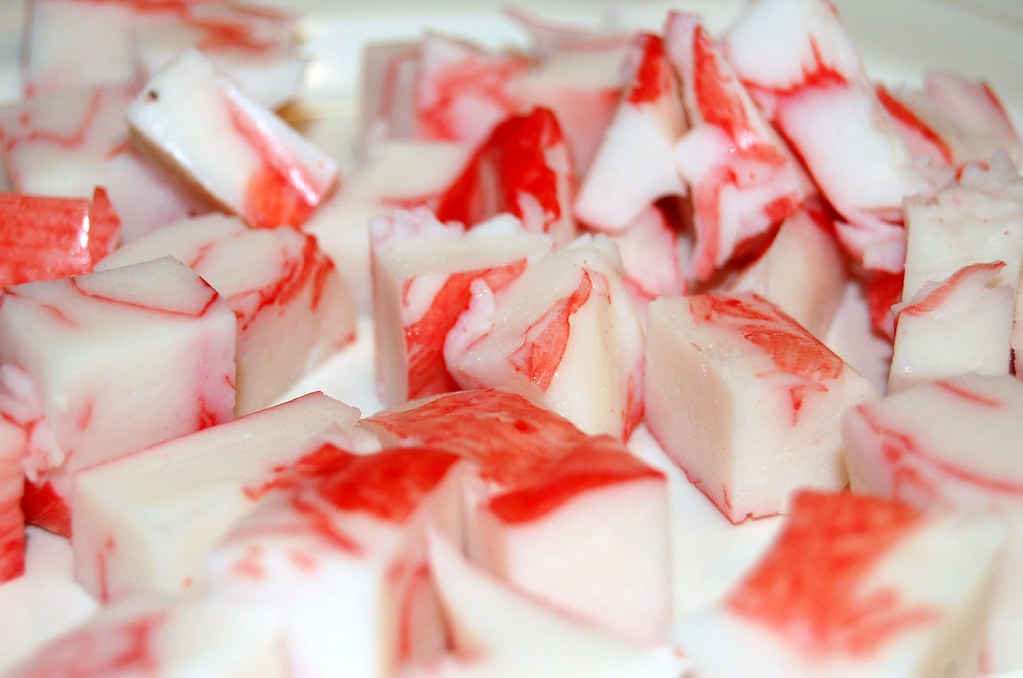White fish, such as pollock, is ground into imitation crab, also known as surimi, which is then shaped into a variety of shapes, such as claws or sticks resembling crabs. To give it a crab-like flavor, it is often spiced with a mixture of herbs and spices.
Since they contain binders made from wheat origins, the majority of imitation crab items are not gluten-free.
How Is Imitation Crab Made?
Imitation crab is created from fish, as was already established. The fish is first pounded into a paste, and then combined with water, starch, and other ingredients to generate a dough-like consistency to make imitation crab. After that, the dough is formed into the proper shape and cooked. The imitation crab is prepared for usage in a number of foods, including sushi, salads, and sandwiches, when it has finished cooking.
In recipes that call for crab meat, imitation crab is frequently used as a flexible and practical substitute for fresh crab. Compared to fresh crab, it is less expensive, more readily available, and has a longer shelf life. However, it is not regarded as a straight replacement because it does not have the same flavor or feel as fresh crab.
Are There Alternatives To Imitation Crab That Are Gluten Free?
Yes, there are a number of gluten-free substitutes for imitation crab. Several possibilities are:
- As a naturally gluten-free seafood choice, lobster can be used in place of imitation crab in a variety of dishes.
- Shrimp: Shrimp can take the place of imitation crab as another seafood alternative that is naturally gluten-free.
- White fish called pollock is frequently used to create mimic crab dishes. Pollock, if you can locate it, is a wonderful gluten-free substitute for imitation crab if it has been prepared in a facility that does not use gluten.
- Another choice that can be used in place of imitation crab in some recipes is canned tuna. Pick a brand that is canned in water or oil, rather than a sauce, as the latter may include gluten.
Are There Any Other Types Of Seafood That Are Likely To Contain Gluten?
Seafood that naturally contains gluten is hardly common. Nevertheless, some fish products might be breaded, coated, or processed in a facility that also processes items containing gluten. Because of cross-contamination, persons who follow a gluten-free diet should avoid using the seafood product.
Products made from shellfish that might include gluten include:
- Battered or breaded seafood: A flour or breadcrumb combination containing gluten may be used to coat some forms of breaded or battered seafood, such as breaded fish sticks or fried shrimp.
- Seafood goods in cans or packages that include additional ingredients: Some seafood products in cans or packages, including canned tuna or salmon, may have additional ingredients like sauces or seasonings that contain gluten.
In order to determine whether packaged fish items include gluten or were processed in a facility that also processes gluten-containing products, it is always a good idea to examine the ingredient list. You should ask the manufacturer for clarification if you are unsure whether a specific seafood item is OK for a gluten-free diet.
Can You Make Imitation Crab At Home That Is Gluten Free?
It is feasible to prepare gluten-free imitation crab at home. Here is a straightforward recipe you could try:
Ingredients:
- 1 pound white fish fillets (such as pollock or cod)
- 1 egg white
- 2 tablespoons potato starch or cornstarch
- 1 teaspoon sugar
- 1/2 teaspoon salt
- 1/2 teaspoon old bay seasoning
- 1/4 teaspoon paprika
Isstruction
- The white fish fillets should be broken up into small pieces and added to a food processor. The fish should be pounded into a fine powder.
- In the food processor, combine the egg white, potato starch or cornstarch, sugar, salt, old bay seasoning, and paprika. Process until the ingredients are well blended and create a paste.
- Use parchment paper to cover a baking sheet.
- Depending on your preference, place spoonfuls of the fish mixture onto the baking sheet and use your hands to form them into long, thin sticks or tiny balls.
- For about an hour, or until the fish sticks or balls are hard, place the baking sheet in the freezer.
- Turn the oven on to 375°F.
- Bake the fish sticks or balls on the baking sheet for 10 to 12 minutes, or until they are well cooked and beginning to become brown..
Instead of wheat flour or other gluten-containing components, this recipe employs cornstarch or potato starch as a binding agent. White fish, which naturally has no gluten, is another key component.
Relevant Articles
Does Black Bean Sauce Have Gluten?

Comments are closed